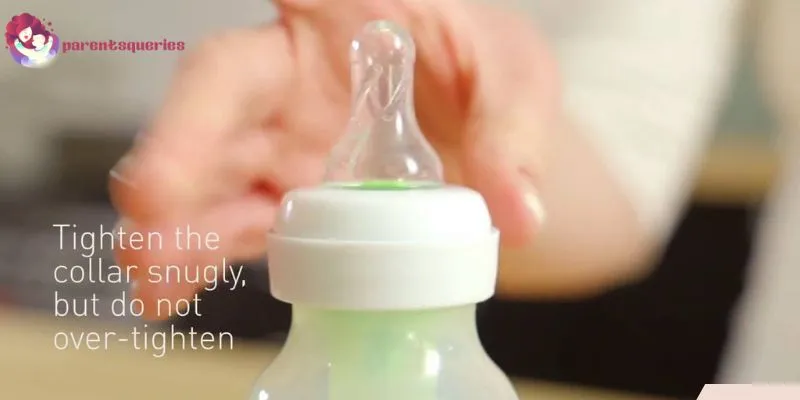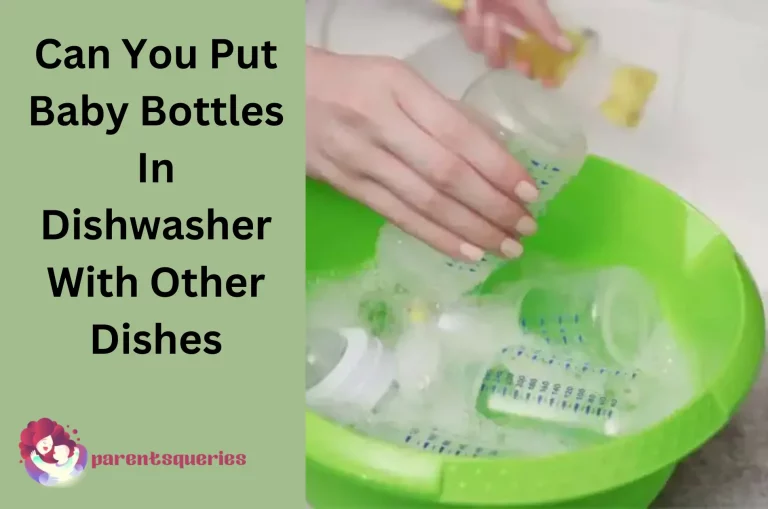Why Dr. Brown’s Bottles Leak And How To Fix It
As a parent of an infant, you must know Dr. Brown’s bottles are the go-to choice for feeding. But what happens when these bottles start leaking?
It can be a real pain to try and figure out why your baby’s bottle is suddenly leaking all over your countertop or in their diaper bag.
This article will explain why Dr. Brown’s bottles leak and provide easy tips on fixing them so you can get back to feeding without worrying about any messes.
Dr. Brown’s recommends these steps:
- Pour the amount you want into your bottle, making sure not to overflow.
- Attach the nipple to the nipple collar and loosely position it on the bottle.
- Follow the warming instructions to heat the bottle.
- Attach the reservoir to the insert by snapping it on.
- Take off the nipple and collar, then put the reservoir in the bottle.
- Finally, place the nipple and collar over the vent system and securely tighten them.
Broken Bottle
Dr. Brown’s Bottles have been a popular choice for parents who want to reduce colic and fussiness in their babies.
However, some users have reported that the bottles can leak, causing frustration and even danger to their little ones. One of the most common issues with these bottles is that they can break easily.
The broken bottle problem has been a concern for many parents using Dr. Brown’s bottles. The glass version of these bottles is particularly fragile and prone to shattering when dropped or mishandled.
This poses a safety risk and leads to wasted milk or formula, which can be expensive and frustrating for parents who are already dealing with sleepless nights. You may like to read Is GFuel For Kids?
Unfortunately, even the plastic versions of Dr. Brown’s bottles are not immune from leaking issues. Some parents have reported that the nipples don’t fit securely onto the bottle, leading to leaks during feeding time.
Check out our complete detailed article about What Bottles Fit Spectra Pump – Full Compatibility Guide.
The Nipple Flow Level Is Too Low
If you are using Dr. Brown’s bottles and have noticed that the nipple flow level is too low, it can be frustrating for both you and your little one. One common issue with Dr. Brown’s bottles is that they tend to leak if the nipple flow level isn’t set correctly.

If your baby seems frustrated during feedings or takes longer than usual to finish their bottle, it could be a sign of a low nipple flow level.
This means that the milk or formula may not be flowing through the nipple as quickly as your baby needs it to, causing them discomfort or frustration.
If the bottle is leaking while your baby is feeding, this can also affect their ability to get enough milk and could lead to air intake which results in gas.
The Bottle Leaked While Traveling
Traveling with a baby can be challenging, especially when it comes to feeding them. Many parents opt for Dr. Brown’s bottles, which are known for reducing colic and providing a natural flow of milk.
However, some parents have reported that the bottles leak during travel, causing a mess and wasting precious breast milk or formula.
One possible reason why Dr. Brown’s bottles may leak during travel is due to changes in air pressure.
When flying or driving through different elevations, the air pressure inside the bottle can fluctuate and cause leaks. Another potential culprit could be an improper assembly of the bottle parts before traveling.

To avoid leaks while traveling with Dr. Brown’s bottles, parents should try prepping their bottles ahead of time by assembling them correctly and checking for any cracks or damage to the nipple or collar.
Bottle Leaks During Preparation
It can be frustrating to spend time preparing your baby’s bottle only to discover that it’s leaking all over your counter or even worse, on your baby.
The problem with Dr. Brown’s bottles is due to the vent system that they use which helps reduce colic and gas in babies.
While this system works well in reducing colic and gas issues in babies, it can sometimes lead to leaks during preparation.
The Bottle’s Collar Is Not Tightened
The bottle collar is an essential component of Dr. Brown’s bottles as it holds the nipple securely in place and prevents leakage during feeding.
If it is not tightened sufficiently, air can enter through gaps between the nipple and collar, causing milk to leak out of the bottle. This can be especially problematic when feeding a hungry baby who requires a steady flow of milk.

To avoid this issue, parents should ensure that they tighten the bottle collar firmly before each use, taking care not to overtighten it as this can cause damage to both the collar and nipple.
You Warmed The Bottle With The Ventilation System Inside
One common mistake parents make is warming the bottle with the ventilation system still attached. This can cause leaks and spillage during feeding time, leaving both you and your little one covered in milk.
Dr. Brown’s bottles are designed with a unique ventilation system that helps reduce colic by preventing air bubbles from forming in the milk.
However, this system needs to be removed before warming up the bottle using any method – whether it’s hot water or an electric bottle warmer – to ensure that there are no leaks or spills during feeding time.
So if you’ve been experiencing leaks with Dr. Brown’s bottles, double-check if you’re removing the ventilation system before warming up the milk.
You Overfilled
Overfilling your baby’s bottle can cause milk to seep out of the nipple, leading to a mess and wasted milk.
It can also cause air to enter the vent system, disrupting its ability to reduce colic and gas in babies. To prevent this from happening, make sure that you fill the bottle only up to the designated fill line on the side of the bottle. check Does Pedialyte Expire?
How To Prevent Dr. Brown’s Bottles Leak?
Dr. Brown’s Bottles are known for their innovative anti-colic design, but they can still sometimes leak if not used correctly.
Check the Vent System
To ensure optimal performance and prevent leaks, it’s important to inspect and clean the vent system regularly. Remove the vent insert and clean it thoroughly with a bottle brush to clear any blockages.
Check for any signs of wear or damage on the vent components and replace them as needed. By maintaining a clean and functional vent system, you can effectively prevent leaks and ensure smooth feeding experiences for your little one.
Assemble Properly
Assembling Dr. Brown’s bottles properly is crucial to prevent leaks and ensure that your baby receives the nourishment they need without any mess or wasted milk.
When assembling the bottle, make sure all the components are clean and dry before putting them together. This will help create a tight seal and minimize the chances of leakage during feeding time.
Tighten the Collar
Tightening the collar is a crucial step that often gets overlooked. Many parents struggle with leaks from their baby’s bottles, causing frustration and wasted formula or breast milk. To avoid this common issue, simply ensure that the collar is screwed on tightly before feeding your little one.
Avoid Overfilling
Overfilling bottles can lead to a mess of leaks, especially with Dr. Brown’s Bottles. To prevent this, it’s important to follow the recommended fill line provided by the manufacturer. Overfilling can put excess pressure on the bottle, causing leaks and spills during feeding time.
Check for Wear and Tear
It’s important to regularly check for wear and tear to prevent leaks and ensure safe feeding for your little one. Even the smallest cracks or scratches can compromise the bottle’s integrity, leading to potential leakage during feeding times.
By taking the time to inspect the bottles for any signs of wear, you can maintain their quality and keep your baby’s feeding experience hassle-free.
Use Correct Nipple Flow
The right nipple flow ensures that the baby gets the perfect amount of milk without causing spillage or excessive air intake.
By using the appropriate nipple flow for your baby’s age and feeding habits, you can significantly reduce the chances of leaks and messes during feeding time.
Hold the Bottle Correctly
Holding the bottle correctly can make all the difference in preventing leaks and ensuring a smooth feeding experience for your little one.
The key is to hold the bottle at a slight angle, allowing the milk to fill the nipple while maintaining a proper seal.
This not only helps to minimize air intake and reduce discomfort for your baby but also prevents unnecessary leaks during feeding time.
Avoid Shaking Vigorously
It’s crucial to avoid shaking them vigorously. Vigorously shaking the bottle might seem like a quick way to mix the contents. It can actually lead to increased air bubbles and potentially cause leaks during feeding time. Instead, gently swirl the bottle to mix the formula or breastmilk with minimal air introduction.
Avoid Overheating
With Dr. Brown’s bottles leak, a common culprit is overheating. Many parents may not realize that overheating can cause the bottle components to expand, leading to seal failure and leaks.
To avoid this issue, use a gentle warming method such as placing the bottle in warm water or using a bottle warmer with precise temperature control.
Always check the temperature of the milk or formula before feeding to ensure it is just right for your baby, without risking damage to the bottle’s integrity.
Clean Thoroughly
Cleaning is paramount. It’s not just about washing the bottle itself, but also paying close attention to the small parts like the vent insert and nipple.
Making sure all components are completely free of milk residue and thoroughly dried can go a long way in maintaining proper functionality and preventing leaks.
Check for Warping
One important step is to regularly check for warping. Over time, the heat from sterilization, dishwasher use, or even just high temperatures can cause the plastic of the bottle to warp, compromising its integrity and leading to potential leaks.
By making it a habit to check for warping on a regular basis, you can ensure that your Dr. Brown’s bottles remain in top condition and continue providing leak-free feeding experiences for your little one.
Replace Damaged Parts
As a parent or caregiver, replacing damaged parts of your baby’s Dr. Brown’s bottles is an essential step in preventing leaks and maintaining the integrity of these popular feeding tools.
Over time, the silicone nipples and vent system can become worn out or damaged through regular use, leading to frustrating leaks during feeding times.
By regularly inspecting and replacing these parts as needed, you can ensure that your baby’s bottle is functioning properly and providing a leak-free feeding experience.
When replacing damaged parts of Dr. Brown’s bottles, it’s important to choose high-quality replacement components that are specifically designed for these bottles. This ensures a proper fit and optimal performance, helping to prevent leaks and maintain the unique anti-colic features that make Dr. Brown’s bottles so popular among parents.
Final Thoughts
Dr. Brown’s bottles do tend to leak. Thankfully, there are several solutions to help resolve the issue. From tightening the cap and ensuring the valves are properly placed, to washing the bottle thoroughly and using a bottle brush as needed, these tips can help you avoid any future leakage.
It is important to remember that prevention is better than cure, so taking proper care of your bottles will significantly reduce any issues with leakage in the long run. Read Can You Wash Baby Bottles In The Dishwasher to learn more about baby bottles.






